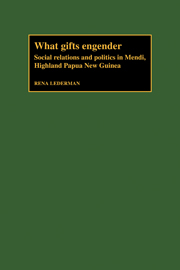Book contents
- Frontmatter
- Contents
- List of tables, figures, and maps
- Preface
- Acknowledgments
- 1 Mendi coming into view
- 2 Sem relations: solidarity and its limits
- 3 Twem: personal exchange partnerships
- 4 Gender ideology and the politics of exchange
- 5 Twem and sem in context
- 6 Sai le at Senkere: the politics of a Pig Festival
- 7 “Development” in Mendi
- Appendix A The research community
- Appendix B The “accounts sample” and some comments on research methodology
- Notes
- Glossary
- References
- Index
2 - Sem relations: solidarity and its limits
Published online by Cambridge University Press: 04 August 2010
- Frontmatter
- Contents
- List of tables, figures, and maps
- Preface
- Acknowledgments
- 1 Mendi coming into view
- 2 Sem relations: solidarity and its limits
- 3 Twem: personal exchange partnerships
- 4 Gender ideology and the politics of exchange
- 5 Twem and sem in context
- 6 Sai le at Senkere: the politics of a Pig Festival
- 7 “Development” in Mendi
- Appendix A The research community
- Appendix B The “accounts sample” and some comments on research methodology
- Notes
- Glossary
- References
- Index
Summary
“In those days, no one slept well at night. Now those times are over. That's good; I am pleased,” Kundapen told me. The old man had just concluded an account of the reasons for the age-old antagonism between his own tribe and their neighbors.
Not everyone agreed with his sentiments, however. Mel [my thoughtful field assistant, who had been a youngster during the 1950s when the Australians imposed peace on Mendi tribes, and who had spent his early twenties in Port Moresby working in the Papua New Guinea army mess] shook his head and asserted that for his part, he wished that he still lived in the days of those “cowboys”!
Introduction
The social geography of the Highlands is a patchwork of clans – landholding groups of kin – linked to one another in political alliances or separated by enmity. In precolonial times, enduring antagonisms between particular groups, erupting into violence on occasion, were dominant facts of life (see, e.g., Meggitt 1977). Warfare inhibited travel, restricting the geographical elaboration of both personal and clan relationships and wealth exchanges. The endemic state of war – more accurately “Warre” in Sahlins's (1968, 1972: Chapter 4) sense – might have been both a means and a result of a political system in which access to force was decentralized. Still, if it was the reflection of a self-help attitude critical to the reproduction of egalitarian social relations, the readiness of tribesmen to take up arms in defense of their interests was not the only means of sustaining such a social order, nor were its modalities entirely egalitarian, as we shall see.
- Type
- Chapter
- Information
- What Gifts EngenderSocial Relations and Politics in Mendi, Highland Papua New Guinea, pp. 19 - 61Publisher: Cambridge University PressPrint publication year: 1986



